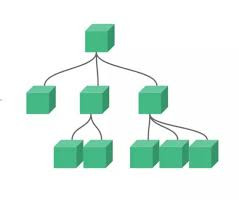元件(Component)是可複用的Vue Instance,並可以定義其名稱。![]()
Vue.js應用程式都是以Instance為主,在加上許多元件組成的。
用蓋房子來比喻,Vue Instance就像地基,而磚塊、瓦片都是元件,最終會組成一間房屋。
每個元件都是各自獨立的Instance,裡面的data不會互相干擾,除了主動做元間的資料傳遞[Props, Emit]後面會提到。

當做出一個元件後,要拿來之前,必須在Vue Instance後註冊才能使用。
註冊又分為 全域註冊、局部註冊
Component的全域註冊,可以直接在頁面上呼叫Component。
使用Vue.component來註冊一個元件,在註冊全域元件時要給予兩個參數,分別為「元件名稱」及「元件物件」
<div id="app">
<global-component></global-component>
</div>
Vue.component('global-component', {
template:`
<div>
{{ message }}
</div>
`,
data: function () {
return {
message: 'Hello Global!'
}
}
})
let app = new Vue({
el: '#app'
})
全域註冊的缺點是,不管有沒有使用到這個元件,其元件一定會載入,會降低網頁速度。
Component的局部註冊是可以重複使用的,在任一個vue Instance用變數定義,這裡要注意,局部註冊的物件,無法在其他頁面/Instance上被使用,需要在其他葉面在註冊一次。
局部註冊是在vue Instance中,定義components變數在掛載在HTML的元素範圍內。
<div id="app">
<local-component></local-component>
</div>
let local = {
template:`
<div>
{{ message }}
</div>
`,
data: function () {
return {
message: 'Hello Local!'
}
}
}
let app= new Vue({
el: '#app',
components: {
'local-component': local
}
})
Component的data需要是function()
在Vue中,元件被定義成可以重複使用的特性,且每個元件的data是獨立的。
如果data是function時,每次註冊元件都匯回傳新的物件,
兩者在差在一個是可以在頁面上直接呼叫Component來使用
另一個則是在vue Instance有需要Component的情況下,要用變數來定義。
Resource
Component 操作手法
元件 Components 簡介